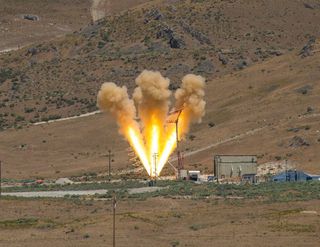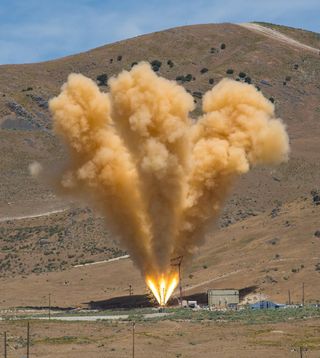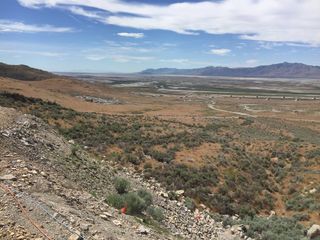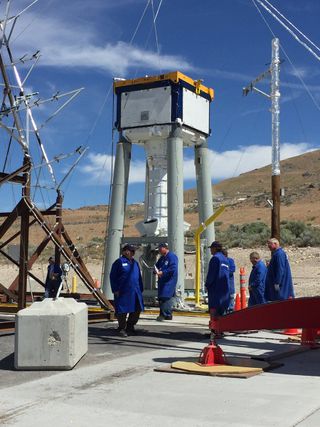Cone of Fire: Orbital ATK Tests Rocket Motor for Orion Astronaut Escape System
A cone-shaped plume of fire and smoke erupted from the floor of the Utah desert today (June 15), during a static test fire of a rocket motor for NASA's next-generation Orion human spacecraft.
The motor will be part of the Orion abort launch system, which would jettison the crew capsule to safety if something went wrong with the primary rocket during launch. The motor rested in a specially designed test stand so that the columns of flame from the engines' four nozzles shot skyward, reaching an expected height of 100 feet (30 meters).
The test took place on schedule at 1 p.m. MDT (3 p.m. EDT/1900 GMT), at Orbital ATK's facility in Corinne, Utah, about 80 miles (128 kilometers) north and slightly west of Salt Lake City. Orbital ATK is also designing and building the twin, five-segment solid rocket boosters NASA's next-generation heavy-lift rocket, the Space Launch System (SLS). [The Orion Space Capsule: NASA's Next Spaceship (Photos)]

"It was a great test," Steve Sara, Orbital ATK's launch abort motor program director, told Space.com. "It was fun to watch, it was a good day to see it, and it was a lot of work that came together for a successful test."

The static fire only lasted 5 seconds, or about as long as the engine will need to fire in the event of an emergency during launch. In case of an emergency — such as the SLS rocket exploding — the abort system would propel the Orion craft away from the rocket.
"We at Orbital ATK are very proud to work with NASA and Lockheed Martin on the Orion Launch Abort System, and to provide a motor that is so integral to astronaut safety," Charlie Precourt, vice president and general manager of Orbital ATK’s Propulsion Systems Division and former NASA astronaut, said in a statement from the company. "The importance of our crews’ safety and well-being can’t be stressed enough."

The launch abort motor is more than 17 feet tall, 3 feet in diameter and can deliver 400,000 pounds of thrust in 0.125 seconds, according to the company. By itself, the abort system can eject the crew capsule to an altitude of up to 300,000 feet (91,400 m). The abort system contains two additional motors: the attitude-control motor (also being built by Orbital ATK) and the jettison motor.
Get the Space.com Newsletter
Breaking space news, the latest updates on rocket launches, skywatching events and more!
Today's test included an increased number of acoustic sensors compared to previous tests. The acoustic vibrations created by the engine create a hostile environment for the other systems on Orion. "I think anyone who has been to a rock concert knows about harsh acoustic environments," said Sara, who spoke with reporters ahead of the test. The data collected during today's test will help other Orion engineers adapt their systems appropriately.
Sara told Space.com the team will analyze data collected during the test and dissect the engine "to be sure that they performed as we thought they would."

This is the first of a series of three planned static test fires of the abort motor; the next test will take place in late 2018, according to the company. Those will be followed by a test of the abort system during flight conditions, called the Ascent Abort-2 Flight Test (AA-2). This test will involve a mock Orion vehicle and a specially built Orbital ATK rocket (rather than an actual SLS rocket), Sara told reporters. That test is scheduled to take place at Cape Canaveral Air Force Station, Florida, in 2019.
The Orion human spaceflight system underwent its maiden test flight in December 2014, although it was not, at the time, qualified to fly humans. NASA has announced that it will send Orion on another uncrewed mission around the moon in 2019. That flight will also be the first test launch of the SLS.
Editor's Note: This article previously stated that Orbital ATK is building the engine for the SLS, which is incorrect; the company is building the rocket's twin five-segment solid rocket boosters.
Follow Calla Cofield @callacofield. Follow us @Spacedotcom, Facebook and Google+. Original article on Space.com.
Join our Space Forums to keep talking space on the latest missions, night sky and more! And if you have a news tip, correction or comment, let us know at: community@space.com.

Calla Cofield joined Space.com's crew in October 2014. She enjoys writing about black holes, exploding stars, ripples in space-time, science in comic books, and all the mysteries of the cosmos. Prior to joining Space.com Calla worked as a freelance writer, with her work appearing in APS News, Symmetry magazine, Scientific American, Nature News, Physics World, and others. From 2010 to 2014 she was a producer for The Physics Central Podcast. Previously, Calla worked at the American Museum of Natural History in New York City (hands down the best office building ever) and SLAC National Accelerator Laboratory in California. Calla studied physics at the University of Massachusetts, Amherst and is originally from Sandy, Utah. In 2018, Calla left Space.com to join NASA's Jet Propulsion Laboratory media team where she oversees astronomy, physics, exoplanets and the Cold Atom Lab mission. She has been underground at three of the largest particle accelerators in the world and would really like to know what the heck dark matter is. Contact Calla via: E-Mail – Twitter
